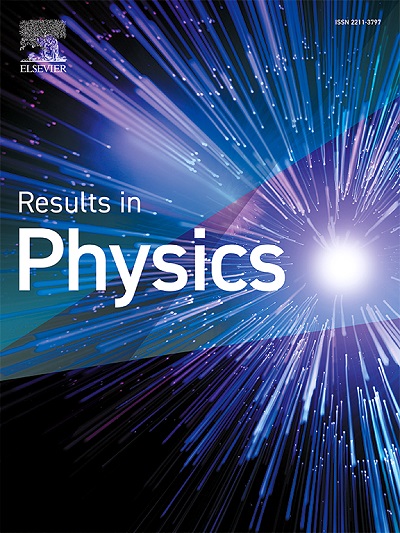ZnSe量子点的合成:稳定剂对其光学性能和结构形貌的影响
IF 4.4
2区 物理与天体物理
Q2 MATERIALS SCIENCE, MULTIDISCIPLINARY
引用次数: 0
摘要
本研究以3-巯基丙酸(MPA)、谷胱甘肽(GSH)和谷胱甘肽-谷胱甘肽的组合为稳定剂,采用胶体法制备了硒化锌量子点(ZnSe QDs)。利用各种技术对量子点进行分析,了解稳定剂对合成量子点光学、形态和结构性质的影响。结果表明,稳定剂的选择对合成量子点的性能有显著影响。MPA-capped量子点的光致发光强度最高(67%),其次是GSH-capped量子点(22%)和MPA-GSH-capped量子点(19%)。紫外可见(UV-Vis)吸收光谱显示了盖层配体的不同波段,并利用TAUC图和吸收光谱拟合方法(DASF)的推导对量子点的能带间隙进行了评价。x射线衍射(XRD)结果表明,MPA和MPA- gsh包封的量子点具有较高的结晶度,而gsh包封的量子点具有较大的尺寸分布的非晶结构。估计的应变和位错密度表明,尽管mpa包覆量子点晶格内部产生的缺陷密度很高,但产生的内应力小于GSH和mpa - GSH包覆量子点。扫描电镜(SEM)结果表明,粒径越大,单分散性越高。相比之下,gsh覆盖的量子点显示出较小的颗粒尺寸,而MPA-GSH显示出混合形态的颗粒。这些发现非常重要,因为它们为调整ZnSe量子点的光学和结构特性提供了有价值的见解,为其在光电子学和生物医学成像中的潜在应用开辟了新的可能性。本文章由计算机程序翻译,如有差异,请以英文原文为准。
Synthesis of ZnSe QDs: Effects of stabilizer on the optical properties and structural morphology
In this study, zinc selenide quantum dots (ZnSe QDs) were synthesized using a colloidal method with three stabilizers: 3-mercaptopropionic acid (MPA), glutathione (GSH), and a combination of MPA-GSH. The QDs were analysed using various techniques to understand the impact of the stabilizers on the optical, morphological and structural properties of the synthesized QDs. The results demonstrate that the choice of stabilizer significantly affects the properties of the synthesized QDs. MPA-capped QDs exhibited superior photoluminescence intensity (67%), followed by GSH-capped QDs (22%) and MPA-GSH-capped QDs (19 %). The ultraviolent visible (UV–Vis) absorption spectra reveal different bands for the capping ligands, and the energy band gap for the QDs was evaluated using the TAUC plots and the derivation of the absorption spectrum fitting method (DASF) method. The X-ray diffraction (XRD) patterns indicate that MPA and MPA-GSH-capped QDs demonstrate higher crystallinity, while GSH-capped QDs show some amorphous structures with broad size distribution. The estimated strain and dislocation density indicate that even though the defect density generated inside the crystalline lattice of MPA-capped QDs is high, the internal stress produced was smaller than GSH and MPA–GSH-capped QDs. The scanning electron microscope (SEM) images for MPA-capped QDs show higher mono-dispersity with bigger particle sizes. In contrast, GSH-capped QDs show smaller particle sizes, and MPA-GSH demonstrated particles with mixed morphology. These findings are important as they provide valuable insights into tuning the optical and structural properties of ZnSe QDs, opening new possibilities for their potential applications in optoelectronics and biomedical imaging.
求助全文
通过发布文献求助,成功后即可免费获取论文全文。
去求助
来源期刊

Results in Physics
MATERIALS SCIENCE, MULTIDISCIPLINARYPHYSIC-PHYSICS, MULTIDISCIPLINARY
CiteScore
8.70
自引率
9.40%
发文量
754
审稿时长
50 days
期刊介绍:
Results in Physics is an open access journal offering authors the opportunity to publish in all fundamental and interdisciplinary areas of physics, materials science, and applied physics. Papers of a theoretical, computational, and experimental nature are all welcome. Results in Physics accepts papers that are scientifically sound, technically correct and provide valuable new knowledge to the physics community. Topics such as three-dimensional flow and magnetohydrodynamics are not within the scope of Results in Physics.
Results in Physics welcomes three types of papers:
1. Full research papers
2. Microarticles: very short papers, no longer than two pages. They may consist of a single, but well-described piece of information, such as:
- Data and/or a plot plus a description
- Description of a new method or instrumentation
- Negative results
- Concept or design study
3. Letters to the Editor: Letters discussing a recent article published in Results in Physics are welcome. These are objective, constructive, or educational critiques of papers published in Results in Physics. Accepted letters will be sent to the author of the original paper for a response. Each letter and response is published together. Letters should be received within 8 weeks of the article''s publication. They should not exceed 750 words of text and 10 references.
 求助内容:
求助内容: 应助结果提醒方式:
应助结果提醒方式:


